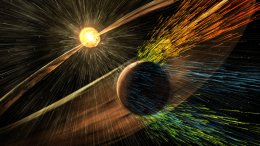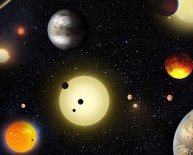
Latest findings of NASA About Earth
 On Thursday, NASA published the first studies from its Mars Atmosphere and Volatile Evolution (MAVEN) mission. The studies — four of which were published in Science — details new data on the Red Planet's disappearing atmosphere. According to MAVEN's findings, the sun is to blame for the planet's current state. Solar wind has stripped away the atmosphere, and continues to do so today.
On Thursday, NASA published the first studies from its Mars Atmosphere and Volatile Evolution (MAVEN) mission. The studies — four of which were published in Science — details new data on the Red Planet's disappearing atmosphere. According to MAVEN's findings, the sun is to blame for the planet's current state. Solar wind has stripped away the atmosphere, and continues to do so today.
[What water on Mars can teach us about scientific ‘breakthroughs’]
The search for water on Mars has undoubtedly been successful. In fact, scientists are now quite certain that the planet was once warm and wet. But if it once had a surface not too unlike Earth's, then how did it become the dry, cold husk it is today? Was it once a place where life could flourish? And could our planet one day follow in its footsteps?
Those are the questions that MAVEN has set out to answer. And now we're one step closer to understanding the evolution of Mars.
The sun is constantly giving off highly energetic particles — also known as solar wind — that travel at around 1 million miles per hour. On Earth, we're mostly protected from these particles by the planet's magnetic field. But Mars doesn't have much of a magnetic field to speak of, so solar particles are able to strip away the molecules of gas that make up its atmosphere. According to data from MAVEN, this happens at a rate of 100 grams per second.
[NASA is looking for new astronauts. Do you have what it takes?]
When the sun is especially active (as it is during solar storms), the atmosphere is stripped even more quickly.
"Like the theft of a few coins from a cash register every day, the loss becomes significant over time, " Bruce Jakosky, MAVEN principal investigator, said in a statement. "We've seen that the atmospheric erosion increases significantly during solar storms, so we think the loss rate was much higher billions of years ago when the sun was young and more active.”
If NASA scientists would simply wind back the clock at the current rate of atmosphere loss, they wouldn't arrive at the starting point of a warm and wet planet. But because our sun would have been more volatile in its youth, we can assume that there were even higher loss rates in the planet's early days.
At a news conference on Thursday, MAVEN scientists explained that Earth would have to lose its magnetic field in order to suffer the same fate — which is highly unlikely. And even if the Earth were left vulnerable to solar wind, we'd be at the mercy of an older, calmer sun.

















